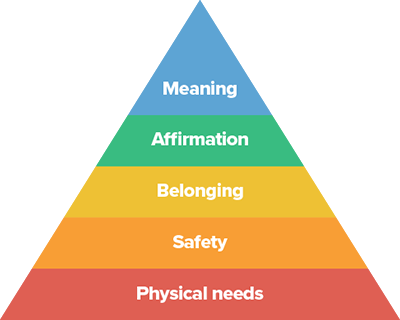Effectively motivating employees has long been one of the most important and challenging duties of a business leader. Part of the challenge is that motivation is highly individualized from one person to the next. So, it’s important for managers and leaders to understand the some of the psychological processes involved in motivation.
At Digital-Tutors, we built an amazing culture, with a laser-focused purpose. We boosted our productivity and profits, while virtually eliminating turnover.
How?
We did it by using a customized version of Maslow’s hierarchy of needs. This concept was proposed by psychologist Abraham Maslow as a way of describing the psychological drivers believed to govern human motivation.
Maslow’s hierarchy is depicted as a pyramid split into five levels, with our most basic physical needs forming the foundation, and advancing through more complex psychological desires at the top of the pyramid. At its core, Maslow’s hierarchy is simple to understand, although applying it in your workplace does require some effort.

Physical needs
This bottom layer of Maslow’s hierarchy represents our most basic biological needs such as food, water, shelter, clothing and sleep. Without these, we cannot survive. Most modern-day workplaces provide for physical needs, whether by law or by social convention. Your staff’s paychecks should be enough that they don’t have to worry about where their next meal is coming from, or where they’ll sleep at night.
Safety needs
Since most modern-day workers don’t have to worry about being eaten by a wild animal in the office, our definitions of safety and security have evolved beyond such considerations. Still though, if an employee feels physically threatened, harassed, or fears for their job security, there’s no way they can excel. Fortunately, there aren’t many companies out there who would blatantly tell their employees that they are disposable.
Only after you’ve provided these bottom two levels of Maslow’s hierarchy can you hope to give your employees the top three layers that I refer to collectively as BAM — that stands for Belonging, Affirmation and Meaning. The more BAM your employees feel at work, the less it’ll seem like work. That’s when people are motivated by something more than a paycheck — they are driven by a purpose that they truly believe in. Let’s explore the top three levels of Maslow’s hierarchy, where happiness and productivity begin to skyrocket.
Belonging
This level is where we start to meet psychological needs such as friendship, family and camaraderie. We want to be part of something — as humans, we’re hardwired to belong to social groups. We want to belong to a tribe, to something bigger than ourselves.
Why do you think team-branded sports apparel is so popular? Because when someone puts on that clothing, they instantly belong to a community of like-minded sports fans. People want to belong.
At my company, we provide our employees with stylish company-branded apparel that they would be proud to wear at any time. On any given day there might be several people walking around the office in company-branded clothing, which goes a long way toward making everyone feel like they’re all part of the same team.
One of the greatest ways to build a sense of belonging is through shared experiences, and the memories they create. Think about doing a yearly retreat with your employees, or optional outings to a local pub every couple of weeks. Quick get-to-know-you activities are also extremely effective. The more shared experiences you can create, the greater the sense of camaraderie.
Affirmation
In this level, we find deeper psychological needs such as self-esteem, achievement and respect. We want to be individually recognized and appreciated in a way that truly means something to us. We desire something that strikes a chord deep inside, not generic praise or an impersonal pat on the back.
So, when affirming your people, don’t just give them the generic “good job today.” Be specific by saying something like “that client asked some tough questions today, and you did a great job of keeping your cool.”
It helps if you take the time to learn how specific employees prefer to receive appreciation. After all, some people may feel uncomfortable being stood up in front of the entire company to be acknowledged. Some people may prefer a simple one-on-one affirmation. For others, a short hand-written card may resonate more.
At the end of the day, just remember to be timely, natural and authentic when giving affirmation. When done in a way that doesn’t feel cheesy or forced, you’ll be amazed at how a little bit of affirmation can significantly boost morale.
Meaning
This highest level of Maslow’s hierarchy unlocks a person’s full potential, tapping into our desire for trust, purpose and empowerment. We want to know that our work is actually making a small difference in the lives of our clients and our tribe. When we feel that higher sense of meaning and purpose, we want to go the extra mile to do our best work. Maslow calls this self-actualization.
Like most other elements of Maslow’s hierarchy, providing your employees with a sense of meaning starts with communication. Help your people to see the big picture of their contributions. Embrace meaning as a part of your culture by sharing stories of happy customers whenever possible. Give your employees the opportunity to share their own stories of how they and their colleagues have succeeded in making someone’s day better.
When you have a company culture where everyone gets BAM from their work, that energy becomes contagious. Everyone wants to know they belong. Everyone wants to be affirmed by their peers. Everyone wants their work to have meaning. If you can do these things for your employees, you will have something that gives you a genuine advantage over your competitors. You’ll be able to attract and retain the most talented and driven individuals, who truly believe in the mission of your company.
BAM isn’t something that can be built overnight — it has to be cultivated from within. It takes time, and it takes commitment. But if you’re willing to see it through, it’s absolutely worth it.





